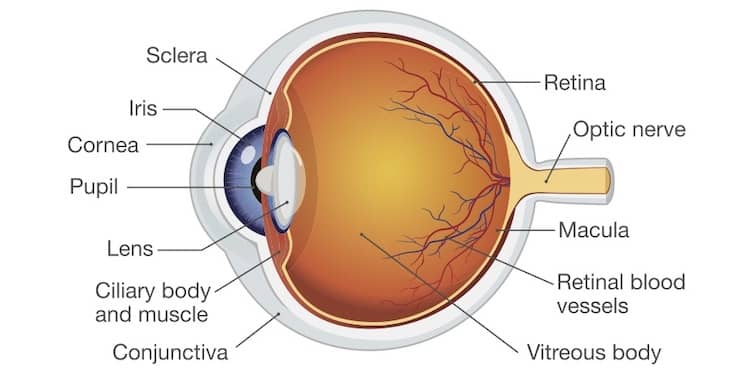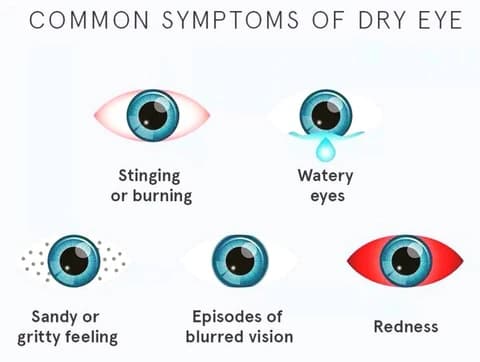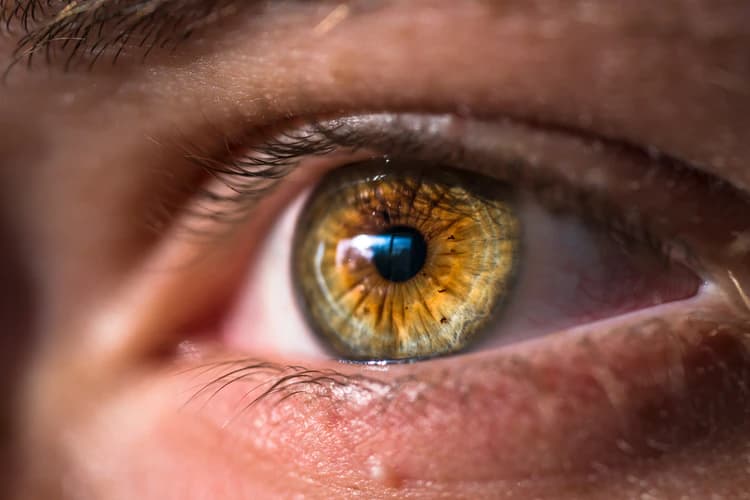Waking Up With Dry Eyes: Causes, Treatment Methods
Dry eye is a disease that shows symptoms in the form of inflammation, stinging and itching in the eye and can occur due to many different reasons.
The main cause of dry eye is the inability of the eye to secrete enough tears.
Tears nourish the cornea and moisturize the surface epithelium. Thus, the cornea becomes a smooth optical surface.
In order to protect eye health, the tear must be of the desired quality in terms of biochemical content.
Tears are made up of three layers: oil, water, and mucus.
Each component protects and nourishes the anterior surface of the eye.
A deficiency in any of the three components can cause tears to evaporate too quickly.
This prevents the tears from spreading evenly across the cornea, leading to dry eyes.
What Will We Learn?
Why Do I wake Up With Dry Eyes?
Waking up with dry eyes is usually caused by a chronic lack of hydration and moisture on the surface of the eye.
This ailment is one of the most common eye conditions worldwide and a major reason for visits to the ophthalmologist.
The tears produced at a slow and steady rate wash the eye throughout the day, keeping it moist and relaxing the eye.
Sometimes the eye does not produce enough tears. In some cases, the quality of tears deteriorates, it cannot keep the eye moist and cannot do its job.
Thanks to the regular blinking action, a tear layer is formed on the surface of the eye that provides smoothness.
This thin layer is not just made up of water.
It contains layers of fat and mucus.
Oil and mucus are produced in the eyelids by the healthy working glands.
Since the sebaceous and mucous glands are affected in eyelid or inner surface infections, a healthy tear layer cannot form.
Therefore, eyelid cleaning is important to reduce the risk of blepharitis and conjunctivitis and related dry eye disease.

What Causes Dry Eyes?
Dry eye occurs due to the decrease in the amount of tears and is manifested by stinging, burning and itching in the eyes.
Insufficient amount and quality of tears makes the eyes more susceptible to infections.
If dry eye is not treated, it can cause serious damage to the cornea, up to inflammation, infection or scarring.
Keeping the eye moist is among the first steps to be taken for eye health.
Also, dry eyes can be a symptom of other underlying diseases.
For this reason, these patients may sometimes need to be seen by doctors from different branches.
Giving the doctor a list of the medicines you are using can help the doctor understand what is causing this condition.
If a person is still itchy or irritated despite using artificial tear drops, they should see an ophthalmologist.
As we age, our eyes begin to age as well, which reduces our tear production.
Although it can occur in both men and women, women are more affected by dry eye.
Many drugs used for a long time can cause dry eye by reducing tear secretion.
Especially long-term use of diuretics, blood pressure-lowering, antiallergic, antidepressant or sleeping pills causes dry eyes.
If a patient with dry eyes also has a joint disease called dry mouth and arthritis, this person is likely to have Sjogren‘s disease.
This is an autoimmune disease and is more common in middle-aged women.
You may also notice our article in which we describe the benefits of sweet potatoes in detail.
What Are The Symptoms Of Dry Eye?
- Complaints of burning in the eyes, feeling of foreign matter
- Itchy eyes
- Excessive sensitivity of the eyes, especially to wind and smoke
- Eyes getting tired quickly while reading
- Difficulty using contact lenses
- Rope-like formations called ‘secretion’ in and around the eye
- Difficulty opening eyes when awakened
- Decreased desire to open eyelids in the evening due to fatigue

How Is Dry Eye Treated?
Dry Eye Drops is one of the most commonly used methods in the treatment of dry eye syndrome.
These drops temporarily wet and lubricate the eye surface.
The diagnosis of this disease is made with a general eye examination.
Information to be obtained from the patient is valuable to reveal the cause.
For a definitive diagnosis, tests that measure tear production are performed.
In a test called the Schirmer test, the amount of tear is measured with a filter paper placed on the inner surface of the lower eyelid.
When necessary, the degree of dryness on the surface of the eye is determined by adding another method, special dye (fluorescein or rose bengal) to the eye.
There are different ways to treat dry eye.
The most common of these is to replace the missing tears.
Artificial tear drops moisten the eye and help reduce complaints and allow the lids to move easily.
Our article on birth control pills will also draw your attention.
In some mild cases, it may be sufficient to use artificial tear drops once or twice a day.
But in some severe cases, it may be necessary to use tear drops every hour.
It is a better idea for people with dry eye disease to use preservative-free single-dose (sine form) eye medications.
The patient’s own method of using tears is another treatment option used to keep the eyes moist.
After staying on the surface of the eye for a certain period of time, the tear flows into the nose with a small channel from the area where the lids called the punctum meet.
That’s why when we cry, water flows from our nose.
Ophthalmologists may close this canal temporarily or permanently with a punctal plug, if appropriate.
Thus, the tears do not flow into the nose and throat and stay on the surface of the eye longer and keep the eye moist for a longer time.
Tablets containing pilocarpine are beneficial in patients with dry eyes and dry mouth.
What Causes Dry Eyes?
Dry eye is more common in cases where the blink reflex is reduced, long-term reading and looking at a computer screen.
Taking preventive measures is as important as treatment.
Dry eye is more common in cases where the blink reflex is reduced, long-term reading and looking at a computer screen.
It is recommended that patients with dry eyes do not go out too much in very hot and windy weather, and stay away from air-blowing devices such as air conditioners and hair dryers.
Wearing glasses is recommended for patients with dry eye to protect them from evaporation of tears.
Patients with dry eyes should avoid rubbing their eyes as this can increase eye irritation.
How To Cure Dry Eyes Permanently?
So far, no permanent cure has been found for dry eyes.
Avoiding the air currents caused by the air conditioner and fan used especially in the summer months does not cure dry eyes permanently, but it prevents the occurrence of dry eye.

What Is The Best Eye Drops For Dry Eyes?
The following are the best eye drops for dry eyes:
- Restasis Eye Drops
- Bausch & Lomb Artelac Advanced Eye Drops
- BioTrue Moisturizing Eye Drops
- Avizor Moisture Lacrifresh – Artificial Tear Drops
- Hy Care Eye Drops
- Optone Eye Drops for Dry Eyes
- Thealoz Duo Eye Drops
- Artican Eye Drops
- Visufarma VisuXL Eye Drops
- Hylo Comod Eye Drops
What Can We Do At Home For Dry Eyes?
The methods that will naturally help dry eyes at home are listed below:
- Olive Oil: Massage your eyelid with a small amount (a few drops) of olive oil 1/2 times a day.
- Green tea: You can brew it warmly once or twice a day with a cloth or cotton ball and apply it to your eyelids.
- Fennel: This herb can also be effective in moisturizing the eyes. Tea made from fennel is placed on the eyelids in a warm state.
- Cucumber: The relaxing effect of cucumber is known against dry eyes that you experience during the day. Slices of a cold cucumber can be put on your eyes and left for a while. You can apply this process several times a day.
- Lavender oil: Lavender oil also has a relaxing effect. It can be mixed with warm water and left on the eyes for 10 minutes. You can apply this process 1-2 times a day.
Result
You may experience dry eye due to different reasons in daily life.
Rheumatoid arthritis, nocturnal lagophthalmos, and not drinking too much fluid can also cause dry eyes.
In addition, rapid tears evaporate can cause eye dryness.
If the pain and itching in your eyes has become unbearable, schedule an appointment with your doctor without waiting.
In some cases, allergies can also cause eye irritation and dry eyes.
Some medical conditions can also cause dry eyes.
The eyelids have meibomian glands, which provide an oily layer that prevents the rapid evaporation of tears.
Dry eyes can also occur when there are problems with these glands.
Sources:
- At a glance: Dry Eye
https://www.nei.nih.gov/learn-about-eye-health/eye-conditions-and-diseases/dry-eye - Effect of Oral Pilocarpine in Treating Severe Dry Eye in Patients With Sjögren Syndrome
https://pubmed.ncbi.nlm.nih.gov/26065354/ - What is good for dry eyes?
https://www.medicalpark.com.tr/goz-kurulugu/hg-2384
